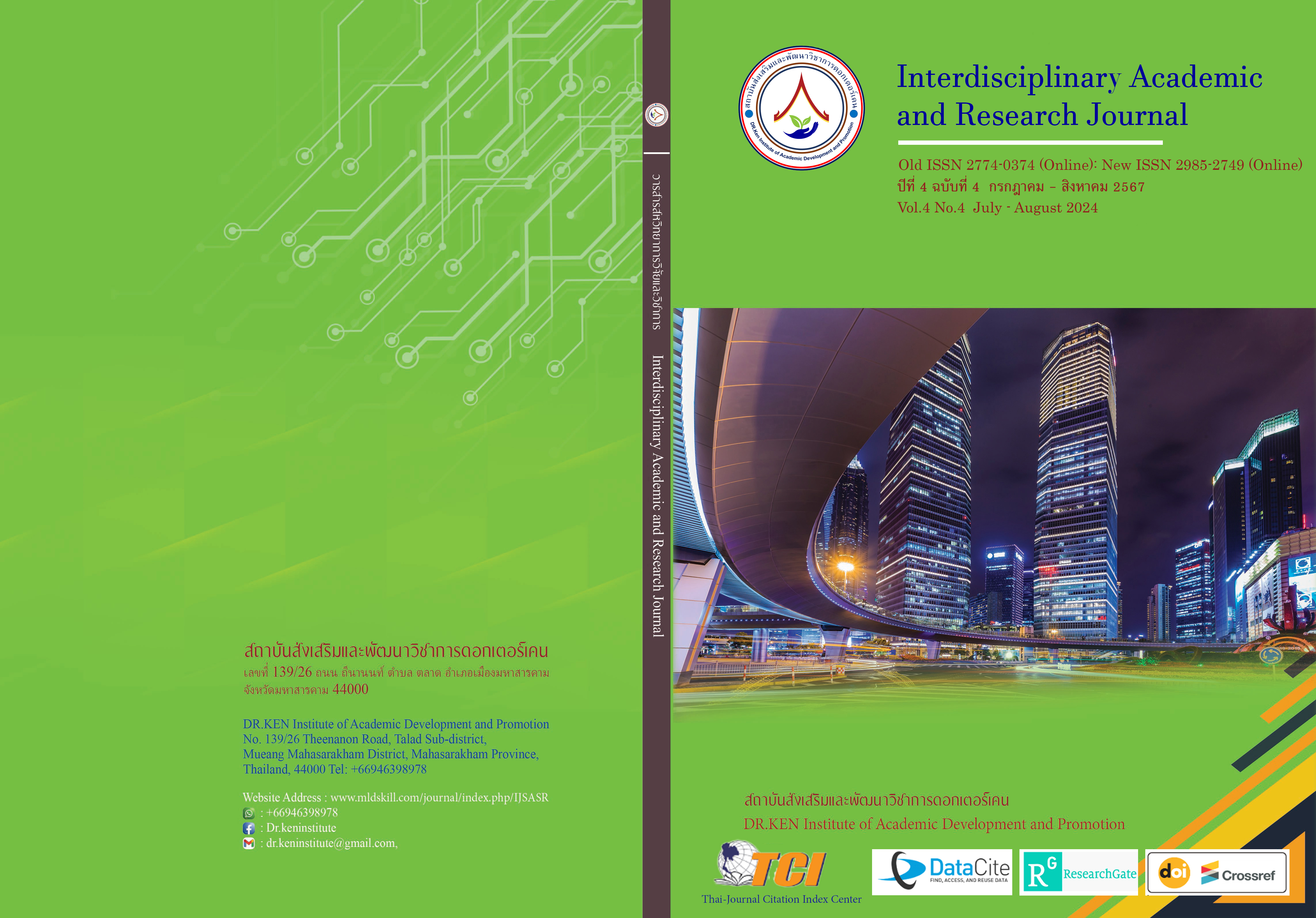The Developing Guidelines for Preventing Drug Problems among Monks in Nongkhai Province
DOI:
https://doi.org/10.60027/iarj.2024.280024Keywords:
Monk; , Drugs;, Guidelines for SolvingAbstract
Background and Aims: The health promotion project for monks in Nong Khai Province included health screening and problem-solving for monks' health issues. A significant health problem identified was the presence of drugs in the urine of monks, highlighting the prevalence of drug use among this influential group in Nong Khai Province. This research aimed to develop guidelines to prevent drug problems among monks in Nong Khai Province.
Methodology: This participatory action research was conducted in three phases: Phase 1 involved studying the context of drug problem prevention among monks through documentary and qualitative research. Phase 2 focused on developing guidelines for preventing drug problems among monks. This qualitative research included a workshop with 50 participants, including district and provincial drug officials, monk representatives, and district abbots from all nine districts.
Phase 3 evaluated the expected outcomes of the prevention guidelines through quantitative research with a sample of 376 abbots.
Results: Phase 1 synthesized a draft of guidelines for preventing drug problems among monks in Nong Khai Province, covering five key issues. Phase 2 refined these guidelines through workshop feedback, adding a screening activity for individuals before ordination. The final guidelines included six main activities: 1) Screening monks for drug use. 2) Screening individuals before ordination as monks or novices. 3) Providing rehabilitation therapy for monks and novices who test positive for drugs, with family and community participation. 4) Conducting educational activities for police monks (Phravinayadhikara) to monitor drug issues among monks. 5) Establishing drug-free temples. 6) Appointing a committee to prevent drug problems among monks in Nong Khai Province. Phase 3 used regression analysis to evaluate the expected outcomes of the prevention guidelines. It was found that the number of years of ordination and the district were significant factors influencing the expected effectiveness of the guidelines, explaining 7.10% of the variance (standard deviation ± 0.466) with the equation: 𝑌= 4.320 – 0.007 (number of years of monkhood) + 0.145 (district).
Conclusion: Participation from monks, the government, the private sector, the community, and families is crucial in promoting the implementation of drug prevention guidelines for monks in Nong Khai Province. The six identified activities form a comprehensive approach to addressing drug problems among monks.
References
กิตติธัช แสนภูวา, และ มณฑา จำปาเหลือง. (2557). ปัจจัยการบริหารที่ส่งผลต่อประสิทธิผลการดำเนินงานแก้ไขยาเสพติด ของโรงเรียนต้นแบบมาตรฐานการต้านยาเสพติดในเขตจังหวัดประจวบคีรีขันธ์และกาญจนบุรี. วารสารวิชาการ Veridian E-Journal, 7(3), 78 - 89.
ตุลา มหาพสุธานนท์. (2554). หลักการจัดการ. กรุงเทพฯ: พี เอ็น เค แอนด์ สกายพริ๊นติ้งส์.
เทอดศักดิ์ ไป่จันทึก, สุนทร ปัญญะพงษ์, อัฐชลี ชัยศรี, และเกศสุดา โภคานิตย์. (2563). ศักยภาพชุมชนในการจัดการปัญหายาเสพติด จังหวัดชัยภูมิ. วารสารวิชาการ มจร.บุรีรัมย์, 5(1), 63 - 73.
ธัญกนกรัชต์ จิรโชคนิธิขโยธร, สมเดช นามเกตุ, และพระครูจิรธรรมรัช. (2565). แนวทางการมีส่วนร่วมในการดำเนินโครงการป้องกันและแก้ไขปัญหายาเสพติดของพระสงฆ์ และประชาชนใขเขตเทศบาลเมืองหนองคาย อำเภอเมืองหนองคาย จังหวัดหนองคาย. Journal of Modern Learning Development, 7(1), 13 - 28.
นุชรีย์ ทองเจิม, ธีรวัฒน์ สกุลมานนท์, และลัดดาวัลย์ สิทธิสาร. (2566). การพัฒนารูปแบบการบำบัดฟื้นฟูผู้ใช้ยาเสพติดโดยชุมชนเป็นฐาน. วารสารพยาบาลบรมราชชนนี สุรินทร์, 13(2), 17 - 30.
พระครูธรรมธรรัตนะ รตนเทโว. (2565). บทบาทพระสงฆ์ในการป้องกันยาเสพติด อำเภอเมือง จังหวัดราชบุรี. วารสารสหวิทยาการนวัตกรรมปริทรรศน์, 5(1), 103 - 112.
พระครูพินิตปริยัติกิจ (สมบัติ วรธมฺโม), พระปลัดระพิน พุทธิสาโร, และ และสุรพล สุยะพรหม. (2561). รูปแบบการมีส่วนร่วมของพระสงฆ์ในการแก้ไขปัญหาการติดยาเสพติด ในเขตปกครองคณะสงฆ์ภาค 2. วารสาร มจร.สังคมศาสตร์ปริทรรศน์, 7(3), 1 - 13.
พระครูสังฆรักษ์ทรวงพรรณ ชัยทตฺโต. (2565). การสร้างเครือข่ายการป้องกันและแก้ไขปัญหายาเพสพติดของคณะสงฆ์ในภาคกลาง. วารสารศิลปการจัดการ, 6(1), 236 - 251.
พระไตรปิฎกออนไลน์. (2561). พระไตรปิฎเล่มที่ 7. เรียกใช้เมื่อ 15 01 2561 จาก http://www.tipitaka.com
พระมหากฤษธิชัย (นากล่อม) กิตฺติธมฺโม. (2565). พระสงฆ์กับการแก้ไขปัญหายาเสพติด. วารสารการบริหารจัดการและนวัตกรรมท้องถิ่น, 4(1), 46 - 52.
พระมหาวุฒิชัย สว่างแสง. (2560). ปัจจัยเสี่ยงต่อการเสพสารเสพติดในพระภิกษุสามเณร. วารสารปรัชญาและศาสนา, 2(2), 70 - 86.
พระวราพงษ์ (ช่วยชู) วรธมฺโม. (2563). แนวทางการป้องกันอบายมุขภายในวัดตามโครงการวัดสีขาว ของอำเภอย่านตาขาว จังหวัดตรัง. วารสารมหาจุฬานาครทรรศน์, 7(3), 79 - 94.
พระสุธีรัตนบัณฑิต. (2565). นโยบายและมาตรการการป้องกันและแก้ไขปัญหายาเสพติดของพระสงฆ์ในสังคมไทย. วารสาร มจร. การพัฒนาสังคม, 7(2), 85 - 97.
ภูภณัช รัตนชัย, พระปลัดสัญญา ชูประดิษฐ์ (สัญฺญโต), และพระครูสมุห์ดิฐภูมิ อินทชาติ (จิรธมฺโม). (2563). ปัญหาในการทำหน้าที่ของพระอุปัชฌาย์ที่ต้องพบและสอบสวนกุลบุตร กรณีศึกษาการติดสุราและยาเสพติดให้โทษก่อนการบรรพชาอุปสมบท. วารสารมนุษยศาสตร์และสังคมศาสตร์ นายเรืออากาศ, 8, 5 - 18.
รังสรรค์ สิงหเลิศ. (2558). ระเบียบวิธีวิจัย และการใช้สถิติสำหรับการวิจัยทางสังคมศาสตร์. มหาสารคาม: บริษัท ทริ๊ปเพิ้น กรุ๊ป จำกัด.
สถาบันวิจัยประชากรและสังคม มหาวิทยาลัยมหิดล. (2567). สุขภาพคนไทย. Called on April 5, 2024 from : https://www.thaihealthreport.com/th/articles_detail.php?id=182.
สำนักงานสาธารณสุขจังหวัดหนองคาย. (2563). สรุปโครงการส่งเสริมสุขภาพพระสงฆ์ - สามเณร จังหวัดหนองคาย ปี 2559 - 2563. กลุ่มงานส่งเสริมสุขภาพ.
สุนทร โคตรบรรเทา, สุเทียบ ละอองทอง, และธนชน อินทจันทร์. (2556). รูปแบบการป้องกันยาเสพติดในสถานศึกษาสังกัดอาชีวศึกษา ในภาคอีสานตอนล่าง. ว.มรม.(มนุษยศาสตร์และสังคมศาสตร์), 7(1), 63 - 71.
อัมพร สีลากุล, วิมาลา เจริญชัย, วิไลรัตน์ สะสมผลสวัสดิ์, ฉวีรักษ์ ลีลา, กนกกาญจน์ วิโรจน์อุไรเรือง, และดารารัตน์ อุ่นศรี. (2556). การพัฒนารูแบบการบำบัดฟื้นฟูผู้เสพยาเสพติดแอมเฟตามีน ด้วยคุณธรรม "รักเหนือรัก" (สาราณีธรรม 6) ระดับศีล 5. การพยาบาลจิตเวชและสุขภาพจิต, 27(3), 30 -42.
Wayne, D. W. (1995). Biostatistics — A Foundations for Analysis in the Health Sciences. 6th edition. New York: Wiley & Sons.
Zuber-Skerritt, O. (1996). Action Research in Higher Education: Examples and Reflection. London: Kogan Page.
Downloads
Published
How to Cite
Issue
Section
License
Copyright (c) 2024 Interdisciplinary Academic and Research Journal

This work is licensed under a Creative Commons Attribution-NonCommercial-NoDerivatives 4.0 International License.
Copyright on any article in the Interdisciplinary Academic and Research Journal is retained by the author(s) under the under the Creative Commons Attribution-NonCommercial-NoDerivatives 4.0 International License. Permission to use text, content, images, etc. of publication. Any user to read, download, copy, distribute, print, search, or link to the full texts of articles, crawl them for indexing, pass them as data to software, or use them for any other lawful purpose. But do not use it for commercial use or with the intent to benefit any business.
















.png)


